Spatial Patterns and Determinants of PM2.5 Concentrations: A Land Use Regression Analysis in Shenyang Metropolitan Area, China
Abstract
:1. Introduction
2. Materials and Methods
2.1. Study Area
2.2. Technique Route
2.3. Dependent Variables
2.4. Predictor Variables
2.5. LUR Modelling and Evaluation
2.6. Pollution Surface Mapping
3. Results
3.1. Descriptive Statistics
3.2. LUR Models
3.3. PM2.5 Pollution Surface Mapping
4. Discussion
4.1. Interpretation of the Impact Factors
4.2. Strategies for PM2.5 Pollution Control
- (1)
- Reduction of source emissions: It is important to focus on lowering direct PM2.5 emissions and levels of precursor pollutants such as NO2 and HCHO identified in the study. The impact of pollutant source emissions on air quality becomes more significant when the influence of surface pressure is more pronounced, due to unfavorable dispersion conditions. This is particularly relevant during winter, when increased heating demand often leads to a rise in pollutant emissions, especially from traditional heating methods. Therefore, the strategy includes: (1) promoting heating renovation projects to improve efficiency by increasing government investment in low-carbon technology and replacing inferior coal with high-quality coal and developing shallow geothermal energy in heavily polluted cities; (2) cleaning existing coal-fired boilers and using natural gas and electric power for cleaner heating; preferring gas heating in areas connected to natural gas, and pilot electric heating or combinations in other areas; and (3) increasing the development of clean energy sources like natural gas, wind, solar, and biomass to replace coal for winter heating [62];
- (2)
- Optimization of vegetative cover and structure: Although there are seasonal differences in the mitigating effects of tree and grassland cover and the aggravating effects of bare vegetation in our model results, they all reflect the effect of surface vegetation cover on improving air quality. Increasing vegetation cover, particularly trees and grasslands, can help lower levels of PM2.5. Strategies should focus on expanding these vegetative types while minimizing areas of bare vegetation. According to the spring model results, the higher the shrub area within a 500 m spatial scale, the higher the PM2.5 concentration. Based on relevant research findings [63], we specifically recommend the following: (1) when using clean air from aloft to dilute pollutants, consider low or ground-cover shrub species; (2) dense shrubs can impede the diffusion of pollutants and act as barriers to isolate pollution sources; (3) vegetation barriers should be composed of tall, high-growing varieties to effectively isolate pollution; and (4) to increase pollution deposition, select vegetations with hairy leaves and a larger leaf area index.
- (3)
- Landscape pattern planning: The study found that the spatial pattern of land use at different scales affected the variations of pollutant concentrations. It is recommended to have a concentrated layout of homogenous land use types near emission sources within approximately 2000 m, particularly those acting as pollution sinks, such as tree and grassland cover. Conversely, at a broader scale (5000 m or more), promoting a balanced distribution of various land uses can enhance the equilibrium between source and sink areas, thereby helping to reduce pollutant levels. It must be acknowledged that this view is still basic and theoretical, and the conclusion may be different for other target pollutants. It is very necessary to further analyze to refine the actual planning and implementation [45];
- (4)
- Regulation of urban activities: The built-up areas, as hotspots for regional pollution, show a distinct feature of higher concentration values than the surrounding areas. Strategies, such as improving infrastructure for public transportation, promoting low-emission and zero-emission vehicles, controlling traffic flow, and raising public awareness of environmental protection can all help to improve air quality [64].
4.3. Limitations
5. Conclusions
Supplementary Materials
Author Contributions
Funding
Institutional Review Board Statement
Informed Consent Statement
Data Availability Statement
Conflicts of Interest
References
- Tucker, W.G. An overview of PM2.5 sources and control strategies. Fuel Process. Technol. 2000, 65–66, 379–392. [Google Scholar] [CrossRef]
- Wan Mahiyuddin, W.R.; Ismail, R.; Mohammad Sham, N.; Ahmad, N.I.; Nik Hassan, N.M.N. Cardiovascular and Respiratory Health Effects of Fine Particulate Matters (PM2.5): A Review on Time Series Studies. Atmosphere 2023, 14, 856. [Google Scholar] [CrossRef]
- Wu, W.; Zhang, Y. Effects of particulate matter (PM2.5) and associated acidity on ecosystem functioning: Response of leaf litter breakdown. Environ. Sci. Pollut. Res. 2018, 25, 30720–30727. [Google Scholar] [CrossRef] [PubMed]
- Zhang, X.; Bao, Z.; Zhang, L.; Zhou, J.; Che, H.; Li, Q.; Tian, M.; Yang, F.; Chen, Y. Biomass burning and aqueous reactions drive the elevation of wintertime PM2.5 in the rural area of the Sichuan basin, China. Atmos. Environ. 2023, 306, 119779. [Google Scholar] [CrossRef]
- Huang, R.-J.; Zhang, Y.; Bozzetti, C.; Ho, K.-F.; Cao, J.-J.; Han, Y.; Daellenbach, K.R.; Slowik, J.G.; Platt, S.M.; Canonaco, F.; et al. High secondary aerosol contribution to particulate pollution during haze events in China. Nature 2014, 514, 218–222. [Google Scholar] [CrossRef] [PubMed]
- Chen, Z.; Chen, D.; Zhao, C.; Kwan, M.-p.; Cai, J.; Zhuang, Y.; Zhao, B.; Wang, X.; Chen, B.; Yang, J.; et al. Influence of meteorological conditions on PM2.5 concentrations across China: A review of methodology and mechanism. Environ. Int. 2020, 139, 105558. [Google Scholar] [CrossRef] [PubMed]
- Dahari, N.; Latif, M.T.; Muda, K.; Hussein, N. Influence of Meteorological Variables on Suburban Atmospheric PM2.5 in the Southern Region of Peninsular Malaysia. Aerosol Air Qual. Res. 2020, 20, 14–25. [Google Scholar] [CrossRef]
- Chen, L.; Shi, L. Differences in urban–rural gradient and driving factors of PM2.5 concentration in the Zhengzhou Metropolitan Area. AirQual. Atmos. Health 2024, 1–15. [Google Scholar] [CrossRef]
- Bilal, M.; Nichol, J.E.; Nazeer, M.; Shi, Y.; Wang, L.; Kumar, K.R.; Ho, H.C.; Mazhar, U.; Bleiweiss, M.P.; Qiu, Z.; et al. Characteristics of Fine Particulate Matter (PM2.5) over Urban, Suburban, and Rural Areas of Hong Kong. Atmosphere 2019, 10, 496. [Google Scholar] [CrossRef]
- Yang, Q.; Yuan, Q.; Yue, L.; Li, T. Investigation of the spatially varying relationships of PM2.5 with meteorology, topography, and emissions over China in 2015 by using modified geographically weighted regression. Environ. Pollut. 2020, 262, 114257. [Google Scholar] [CrossRef] [PubMed]
- Jin, J.; Liu, S.; Wang, L.; Wu, S.; Zhao, W. Fractional Vegetation Cover and Spatiotemporal Variations of PM2.5 Concentrations in the Beijing-Tianjin-Hebei Region of China. Atmosphere 2022, 13, 1850. [Google Scholar] [CrossRef]
- Ryu, J.; Kim, J.J.; Byeon, H.; Go, T.; Lee, S.J. Removal of fine particulate matter (PM2.5) via atmospheric humidity caused by evapotranspiration. Environ. Pollut. 2019, 245, 253–259. [Google Scholar] [CrossRef] [PubMed]
- Wu, J.; Xie, W.; Li, W.; Li, J. Effects of Urban Landscape Pattern on PM2.5 Pollution—A Beijing Case Study. PLoS ONE 2015, 10, e0142449. [Google Scholar] [CrossRef] [PubMed]
- Shi, Y.; Lau, K.K.L.; Ng, E. Developing Street-Level PM2.5 and PM10 Land Use Regression Models in High-Density Hong Kong with Urban Morphological Factors. Environ. Sci. Technol. 2016, 50, 8178–8187. [Google Scholar] [CrossRef] [PubMed]
- Hoek, G.; Beelen, R.; de Hoogh, K.; Vienneau, D.; Gulliver, J.; Fischer, P.; Briggs, D. A review of land-use regression models to assess spatial variation of outdoor air pollution. Atmos. Environ. 2008, 42, 7561–7578. [Google Scholar] [CrossRef]
- Ma, X.; Zou, B.; Deng, J.; Gao, J.; Longley, I.; Xiao, S.; Guo, B.; Wu, Y.; Xu, T.; Xu, X.; et al. A comprehensive review of the development of land use regression approaches for modeling spatiotemporal variations of ambient air pollution: A perspective from 2011 to 2023. Environ. Int. 2024, 183, 108430. [Google Scholar] [CrossRef] [PubMed]
- Hystad, P.; Setton, E.; Cervantes, A.; Poplawski, K.; Deschenes, S.; Brauer, M.; van Donkelaar, A.; Lamsal, L.; Martin, R.; Jerrett, M.; et al. Creating National Air Pollution Models for Population Exposure Assessment in Canada. Environ. Health Perspect. 2011, 119, 1123–1129. [Google Scholar] [CrossRef] [PubMed]
- Shi, T.; Dirienzo, N.; Requia, W.J.; Hatzopoulou, M.; Adams, M.D. Neighbourhood scale nitrogen dioxide land use regression modelling with regression kriging in an urban transportation corridor. Atmos. Environ. 2020, 223, 117218. [Google Scholar] [CrossRef]
- Marshall, J.D.; Nethery, E.; Brauer, M. Within-urban variability in ambient air pollution: Comparison of estimation methods. Atmos. Environ. 2008, 42, 1359–1369. [Google Scholar] [CrossRef]
- Wang, M.; Gehring, U.; Hoek, G.; Keuken, M.; Jonkers, S.; Beelen, R.; Eeftens, M.; Postma, D.S.; Brunekreef, B. Air Pollution and Lung Function in Dutch Children: A Comparison of Exposure Estimates and Associations Based on Land Use Regression and Dispersion Exposure Modeling Approaches. Environ. Health Perspect. 2015, 123, 847–851. [Google Scholar] [CrossRef] [PubMed]
- Johnson, M.; Clark, N.; Martin, R.; van Donkelaar, A.; Lamsal, L.; Grgicak-Mannion, A.; Chen, H.; Davidson, A.; Villeneuve, P. Comparison of Remote Sensing, Land-use Regression, and Fixed-site Monitoring Approaches for Estimating Exposure to Ambient Air Pollution Within a Canadian Population-based Study of Respiratory and Cardiovascular Health. Epidemiology 2011, 22, S139. [Google Scholar] [CrossRef]
- de Hoogh, K.; Korek, M.; Vienneau, D.; Keuken, M.; Kukkonen, J.; Nieuwenhuijsen, M.J.; Badaloni, C.; Beelen, R.; Bolignano, A.; Cesaroni, G.; et al. Comparing land use regression and dispersion modelling to assess residential exposure to ambient air pollution for epidemiological studies. Environ. Int. 2014, 73, 382–392. [Google Scholar] [CrossRef] [PubMed]
- Eeftens, M.; Beelen, R.; de Hoogh, K.; Bellander, T.; Cesaroni, G.; Cirach, M.; Declercq, C.; Dėdelė, A.; Dons, E.; de Nazelle, A.; et al. Development of Land Use Regression Models for PM2.5, PM2.5 Absorbance, PM10 and PMcoarse in 20 European Study Areas; Results of the ESCAPE Project. Environ. Sci. Technol. 2012, 46, 11195–11205. [Google Scholar] [CrossRef] [PubMed]
- Shi, T.; Hu, Y.; Liu, M.; Li, C.; Zhang, C.; Liu, C. Land use regression modelling of PM2.5 spatial variations in different seasons in urban areas. Sci. Total Environ. 2020, 743, 140744. [Google Scholar] [CrossRef] [PubMed]
- Zhang, C.; Hu, Y.; Adams, M.D.; Bu, R.; Xiong, Z.; Liu, M.; Du, Y.; Li, B.; Li, C. Distribution patterns and influencing factors of population exposure risk to particulate matters based on cell phone signaling data. Sust. Cities Soc. 2023, 89, 104346. [Google Scholar] [CrossRef]
- Lin, C.-H.; Wen, T.-H. Using geographically weighted regression (GWR) to explore spatial varying relationships of immature mosquitoes and human densities with the incidence of dengue. Int. J. Environ. Res. Public Health 2011, 8, 2798–2815. [Google Scholar] [CrossRef] [PubMed]
- Leong, Y.-Y.; Yue, J.C. A modification to geographically weighted regression. Int. J. Health Geogr. 2017, 16, 11. [Google Scholar] [CrossRef] [PubMed]
- Sun, Y.; Luo, Z.; Fan, X. Robust structured heterogeneity analysis approach for high-dimensional data. Stat. Med. 2022, 41, 3229–3259. [Google Scholar] [CrossRef] [PubMed]
- Wu, J.; Wang, Y.; Liang, J.; Yao, F. Exploring common factors influencing PM2.5 and O3 concentrations in the Pearl River Delta: Tradeoffs and synergies. Environ. Pollut. 2021, 285, 117138. [Google Scholar] [CrossRef] [PubMed]
- Zhang, P.; Ma, W.; Wen, F.; Liu, L.; Yang, L.; Song, J.; Wang, N.; Liu, Q. Estimating PM2.5 concentration using the machine learning GA-SVM method to improve the land use regression model in Shaanxi, China. Ecotoxicol. Environ. Saf. 2021, 225, 112772. [Google Scholar] [CrossRef] [PubMed]
- Wood, S.N. Fast Stable Direct Fitting and Smoothness Selection for Generalized Additive Models. J. R. Stat. Soc. Ser. B Stat. Methodol. 2008, 70, 495–518. [Google Scholar] [CrossRef]
- Tella, A.; Balogun, A.-L.; Adebisi, N.; Abdullah, S. Spatial assessment of PM10 hotspots using Random Forest, K-Nearest Neighbour and Naïve Bayes. Atmos. Pollut. Res. 2021, 12, 101202. [Google Scholar] [CrossRef]
- Adams, M.D.; Kanaroglou, P.S. Mapping real-time air pollution health risk for environmental management: Combining mobile and stationary air pollution monitoring with neural network models. J. Environ. Manag. 2015, 168, 133. [Google Scholar] [CrossRef] [PubMed]
- Linardatos, P.; Papastefanopoulos, V.; Kotsiantis, S. Explainable AI: A Review of Machine Learning Interpretability Methods. Entropy 2021, 23, 18. [Google Scholar] [CrossRef] [PubMed]
- Yang, Z.; Freni-Sterrantino, A.; Fuller, G.W.; Gulliver, J. Development and transferability of ultrafine particle land use regression models in London. Sci. Total Environ. 2020, 740, 140059. [Google Scholar] [CrossRef] [PubMed]
- Wang, R.; Henderson, S.B.; Sbihi, H.; Allen, R.W.; Brauer, M. Temporal stability of land use regression models for traffic-related air pollution. Atmos. Environ. 2013, 64, 312–319. [Google Scholar] [CrossRef]
- Das, K.; Das Chatterjee, N.; Jana, D.; Bhattacharya, R.K. Application of land-use regression model with regularization algorithm to assess PM2.5 and PM10 concentration and health risk in Kolkata Metropolitan. Urban Clim. 2023, 49, 101473. [Google Scholar] [CrossRef]
- Myga-Piątek, U.; Żemła-Siesicka, A.; Pukowiec-Kurda, K.; Sobala, M.; Nita, J. Is There Urban Landscape in Metropolitan Areas? An Unobvious Answer Based on Corine Land Cover Analyses. Land 2021, 10, 51. [Google Scholar] [CrossRef]
- Huang, D.; He, B.; Wei, L.; Sun, L.; Li, Y.; Yan, Z.; Wang, X.; Chen, Y.; Li, Q.; Feng, S. Impact of land cover on air pollution at different spatial scales in the vicinity of metropolitan areas. Ecol. Indic. 2021, 132, 108313. [Google Scholar] [CrossRef]
- GB/T 42074-2022; Division of Climatic Seasons. State Administration for Market Regulation, Standardization Administration: Beijing, China, 2022. Available online: https://openstd.samr.gov.cn/bzgk/gb/newGbInfo?hcno=2CC96F656DE7E1641FEA09766A87FDD3 (accessed on 12 October 2022).
- Wang, S.; Li, Y.; Haque, M. Evidence on the Impact of Winter Heating Policy on Air Pollution and Its Dynamic Changes in North China. Sustainability 2019, 11, 2728. [Google Scholar] [CrossRef]
- Guo, B.; Wu, H.J.; Pei, L.; Zhu, X.W.; Zhang, D.M.; Wang, Y.; Luo, P.P. Study on the spatiotemporal dynamic of ground-level ozone concentrations on multiple scales across China during the blue sky protection campaign. Environ. Int. 2022, 170, 107606. [Google Scholar] [CrossRef] [PubMed]
- Lawrence, M.G. The Relationship between Relative Humidity and the Dewpoint Temperature in Moist Air: A Simple Conversion and Applications. Bull. Am. Meteorol. Soc. 2005, 86, 225–234. [Google Scholar] [CrossRef]
- Liang, L.; Gong, P. Urban and air pollution: A multi-city study of long-term effects of urban landscape patterns on air quality trends. Sci. Rep. 2020, 10, 18618. [Google Scholar] [CrossRef] [PubMed]
- Feng, H.; Zou, B.; Tang, Y. Scale- and Region-Dependence in Landscape-PM2.5 Correlation: Implications for Urban Planning. Remote Sens. 2017, 9, 918. [Google Scholar] [CrossRef]
- Hesselbarth, M.H.K.; Sciaini, M.; With, K.A.; Wiegand, K.; Nowosad, J. landscapemetrics: An open-source R tool to calculate landscape metrics. Ecography 2019, 42, 1648–1657. [Google Scholar] [CrossRef]
- Friedman, J.; Hastie, T.; Tibshirani, R. Regularization paths for generalized linear models via coordinate descent. J. Stat. Softw. 2010, 33, 1–22. [Google Scholar] [CrossRef] [PubMed]
- Zeng, S.; Zhang, Y. The Effect of Meteorological Elements on Continuing Heavy Air Pollution: A Case Study in the Chengdu Area during the 2014 Spring Festival. Atmosphere 2017, 8, 71. [Google Scholar] [CrossRef]
- Dong, Z.; Yu, X.; Li, X.; Dai, J. Analysis of variation trends and causes of aerosol optical depth in Shaanxi Province using MODIS data. Chin. Sci. Bull. 2013, 58, 4486–4496. [Google Scholar] [CrossRef]
- Zhai, H.; Yao, J.; Wang, G.; Tang, X. Study of the Effect of Vegetation on Reducing Atmospheric Pollution Particles. Remote Sens. 2022, 14, 1255. [Google Scholar] [CrossRef]
- Jia, M.; Zhao, T.; Cheng, X.; Gong, S.; Zhang, X.; Tang, L.; Liu, D.; Wu, X.; Wang, L.; Chen, Y. Inverse Relations of PM2.5 and O3 in Air Compound Pollution between Cold and Hot Seasons over an Urban Area of East China. Atmosphere 2017, 8, 59. [Google Scholar] [CrossRef]
- Suthar, G.; Singhal, R.P.; Khandelwal, S.; Kaul, N.; Parmar, V.; Singh, A.P. Four-year Spatiotemporal Distribution & Analysis of PM2.5 and its Precursor Air Pollutant SO2, NO2 & NH3 and their Impact on LST in Bengaluru City, India. IOP Conf. Ser. Earth Environ. Sci. 2022, 1084, 012036. [Google Scholar] [CrossRef]
- He, H.S.; DeZonia, B.E.; Mladenoff, D.J. An aggregation index (AI) to quantify spatial patterns of landscapes. Landsc. Ecol. 2000, 15, 591–601. [Google Scholar] [CrossRef]
- Jaeger, J.A.G. Landscape division, splitting index, and effective mesh size: New measures of landscape fragmentation. Landsc. Ecol. 2000, 15, 115–130. [Google Scholar] [CrossRef]
- Liu, H.-L.; Shen, Y.-S. The Impact of Green Space Changes on Air Pollution and Microclimates: A Case Study of the Taipei Metropolitan Area. Sustainability 2014, 6, 8827–8855. [Google Scholar] [CrossRef]
- Xing, Y.; Brimblecombe, P. Role of vegetation in deposition and dispersion of air pollution in urban parks. Atmos. Environ. 2019, 201, 73–83. [Google Scholar] [CrossRef]
- He, C.; Qiu, K.; Alahmad, A.; Pott, R. Particulate matter capturing capacity of roadside evergreen vegetation during the winter season. Urban For. Urban Green. 2020, 48, 126510. [Google Scholar] [CrossRef]
- Wang, Y.; Gao, W.; Wang, S.; Song, T.; Gong, Z.; Ji, D.; Wang, L.; Liu, Z.; Tang, G.; Huo, Y.; et al. Contrasting trends of PM2.5 and surface-ozone concentrations in China from 2013 to 2017. Natl. Sci. Rev. 2020, 7, 1331–1339. [Google Scholar] [CrossRef] [PubMed]
- Ma, Y.; Wang, M.; Wang, S.; Wang, Y.; Feng, L.; Wu, K. Air pollutant emission characteristics and HYSPLIT model analysis during heating period in Shenyang, China. Environ. Monit. Assess. 2020, 193, 9. [Google Scholar] [CrossRef] [PubMed]
- Sun, J.; Gong, J.; Zhou, J.; Liu, J.; Liang, J. Analysis of PM2.5 pollution episodes in Beijing from 2014 to 2017: Classification, interannual variations and associations with meteorological features. Atmos. Environ. 2019, 213, 384–394. [Google Scholar] [CrossRef]
- Ma, Y.; Zhao, H.; Liu, Q. Characteristics of PM2.5 and PM10 pollution in the urban agglomeration of Central Liaoning. Urban Clim. 2022, 43, 101170. [Google Scholar] [CrossRef]
- Cai, H.; Nan, Y.; Zhao, Y.; Jiao, W.; Pan, K. Impacts of winter heating on the atmospheric pollution of northern China’s prefectural cities: Evidence from a regression discontinuity design. Ecol. Indic. 2020, 118, 106709. [Google Scholar] [CrossRef]
- Janhäll, S. Review on urban vegetation and particle air pollution—Deposition and dispersion. Atmos. Environ. 2015, 105, 130–137. [Google Scholar] [CrossRef]
- Jonidi Jafari, A.; Charkhloo, E.; Pasalari, H. Urban air pollution control policies and strategies: A systematic review. J. Environ. Health Sci. Eng. 2021, 19, 1911–1940. [Google Scholar] [CrossRef] [PubMed]
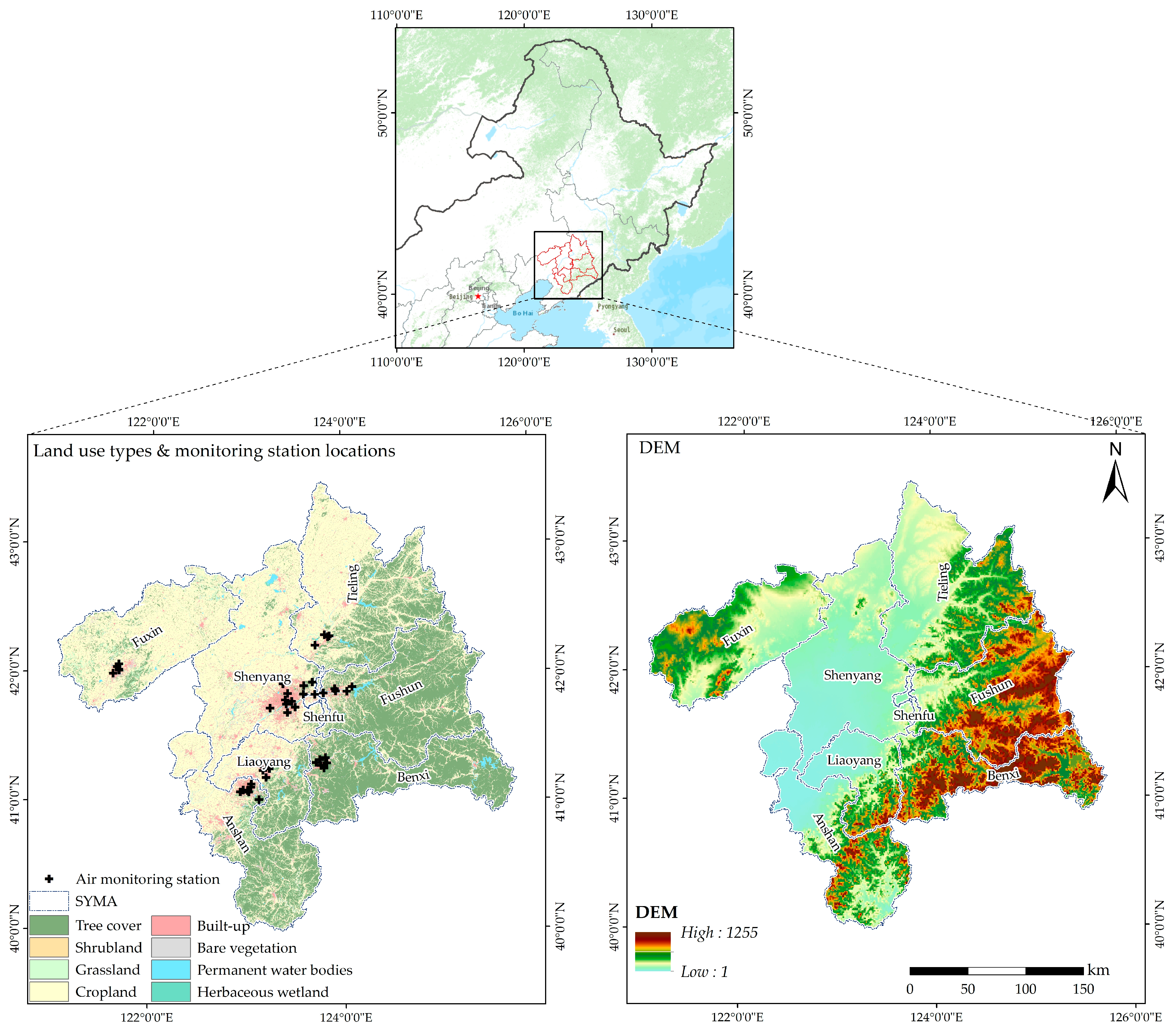
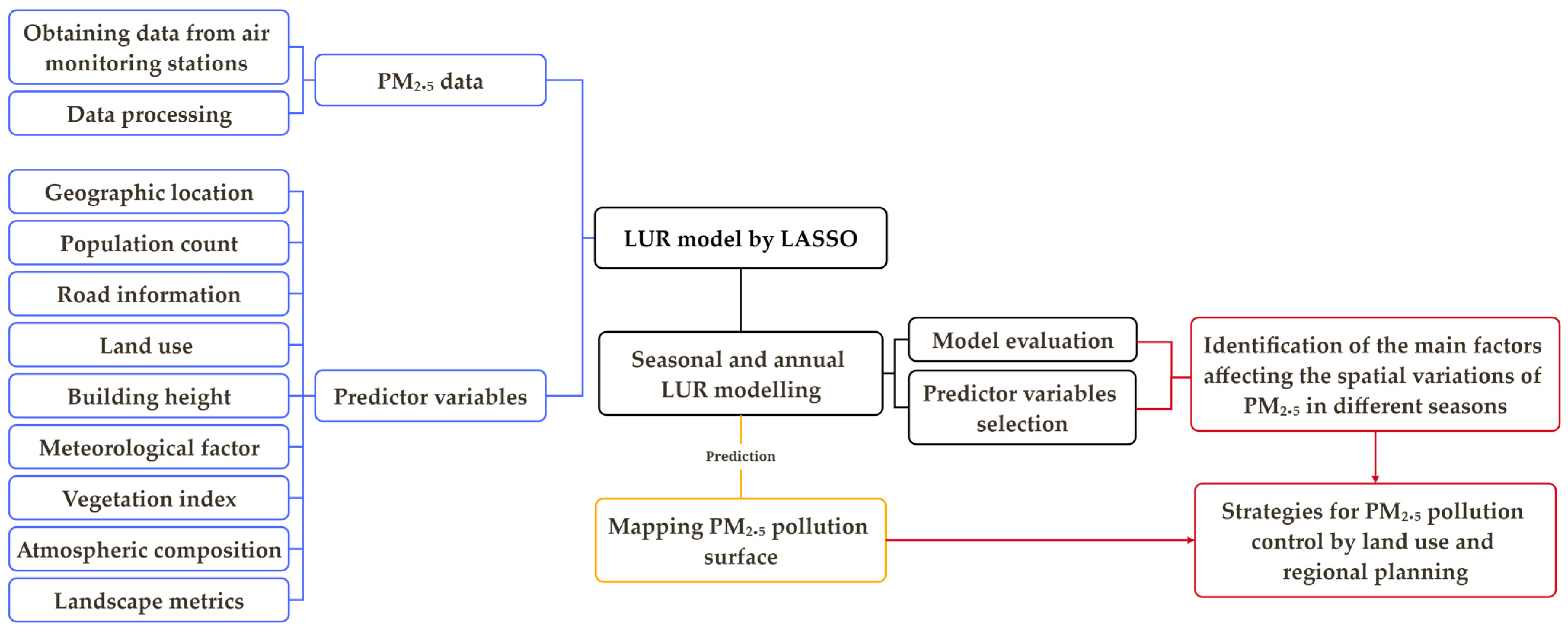
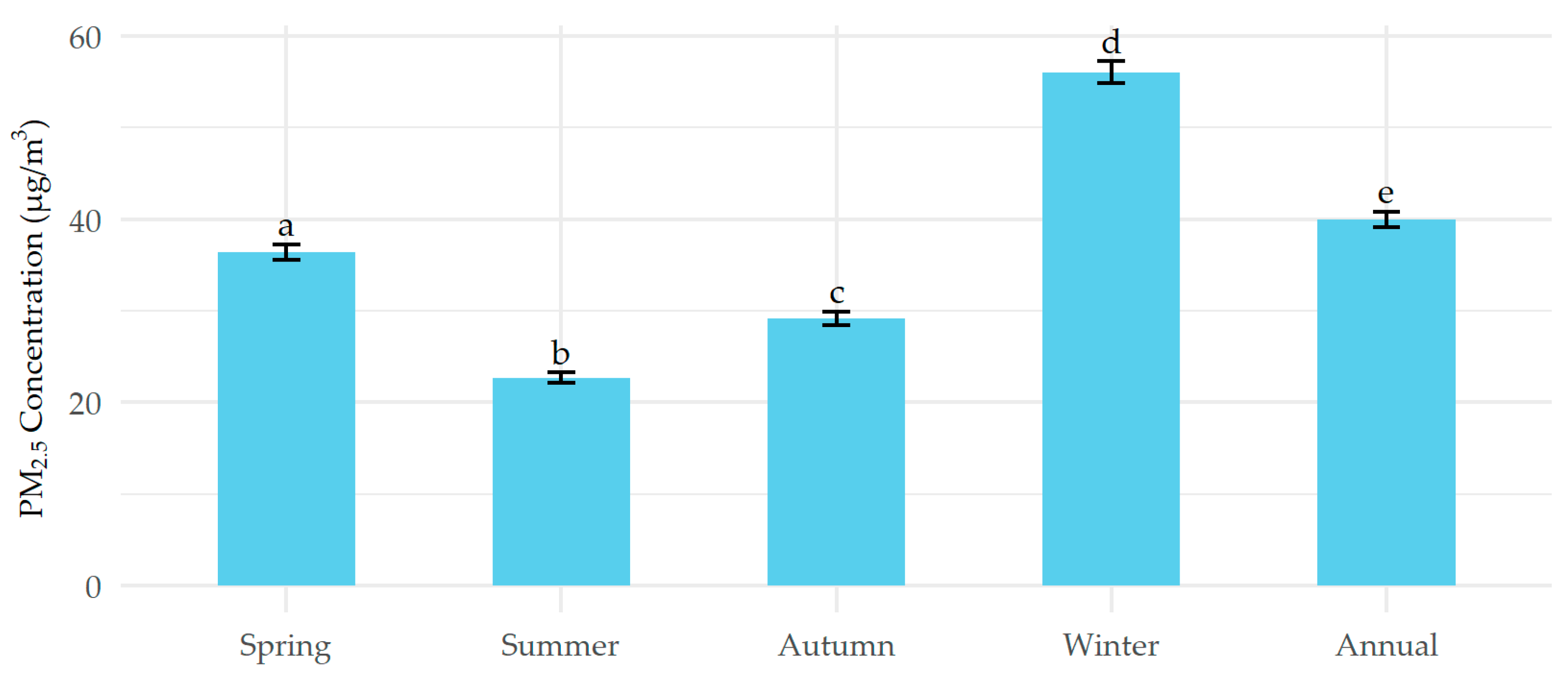

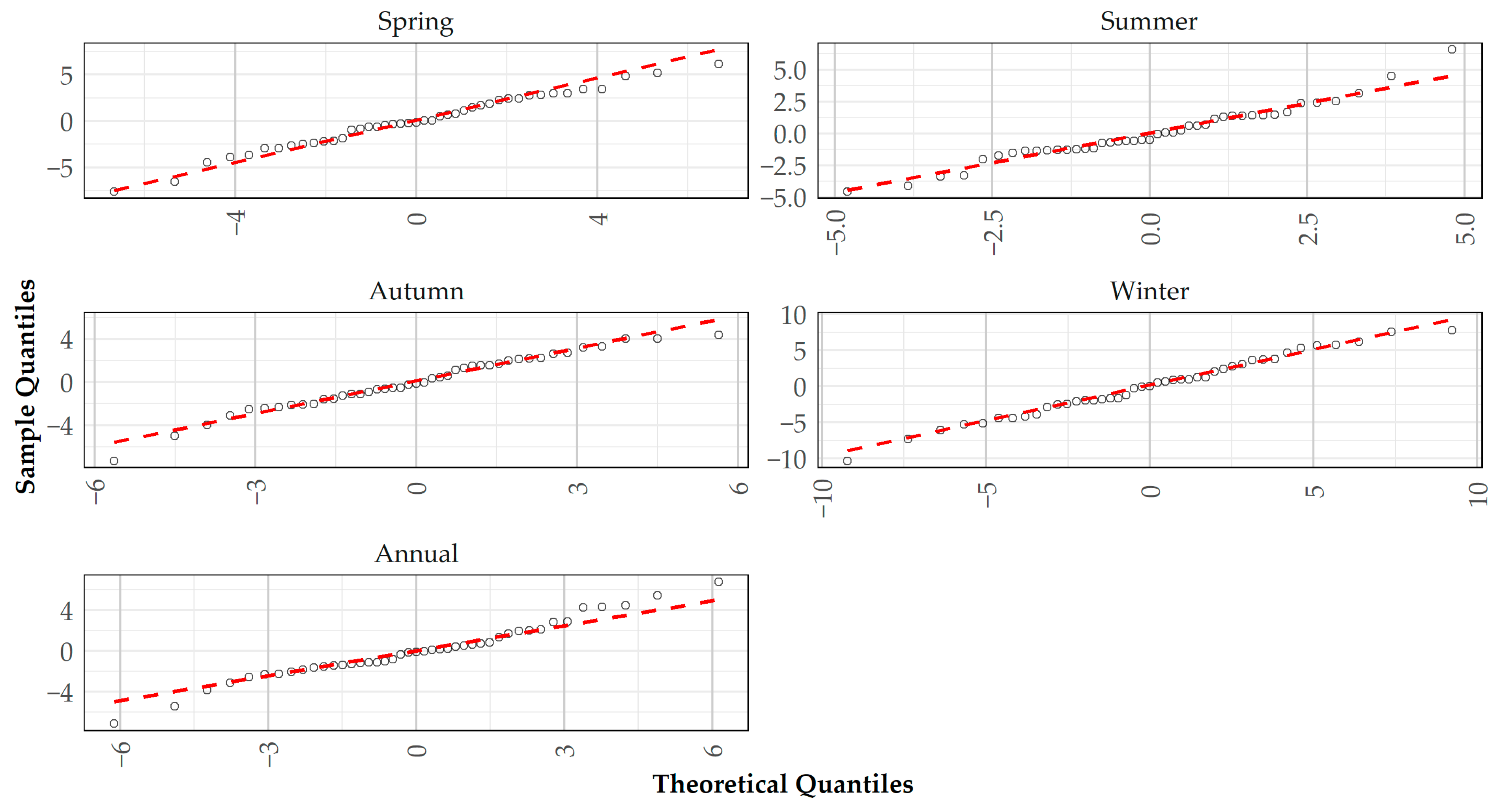
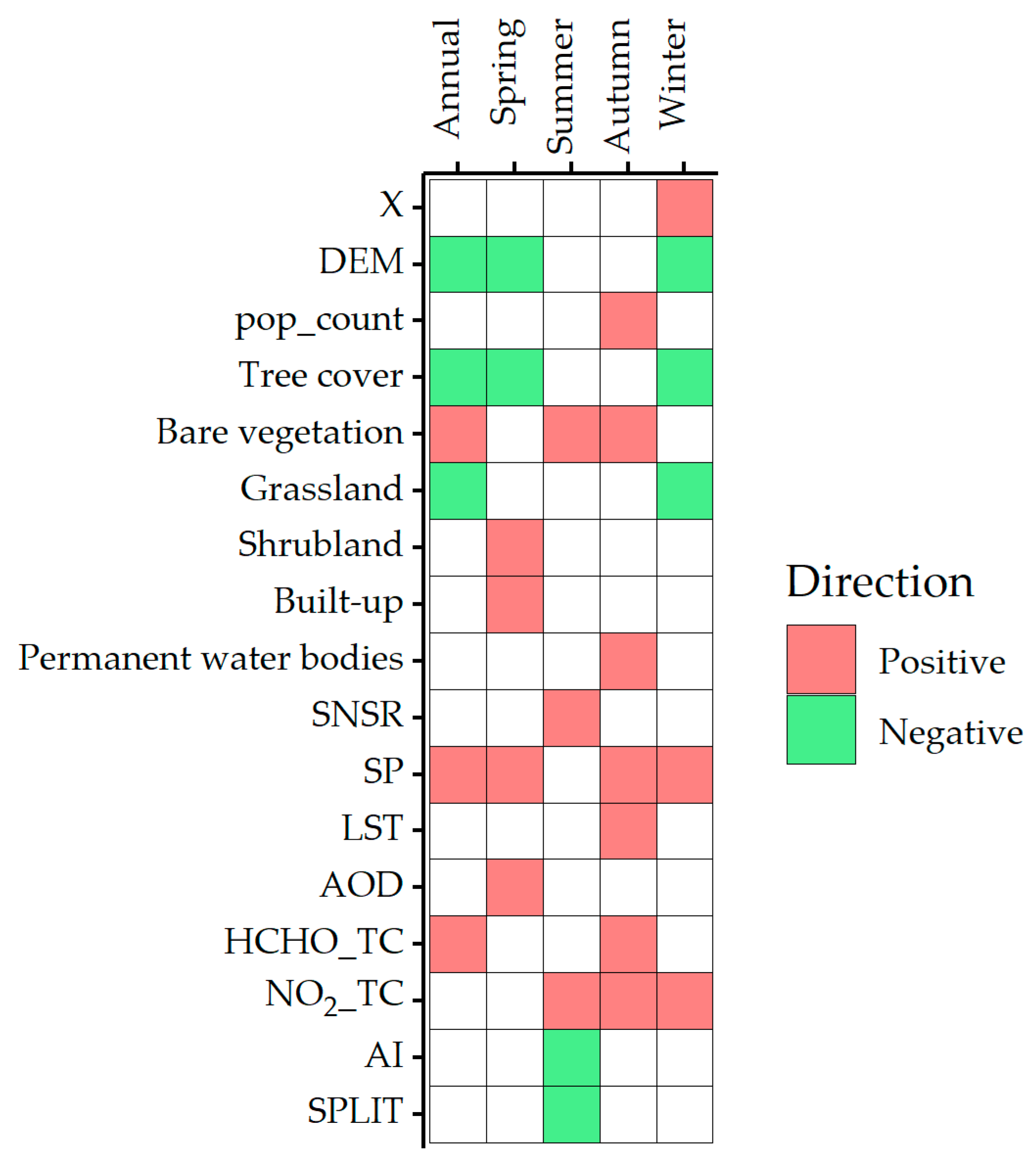

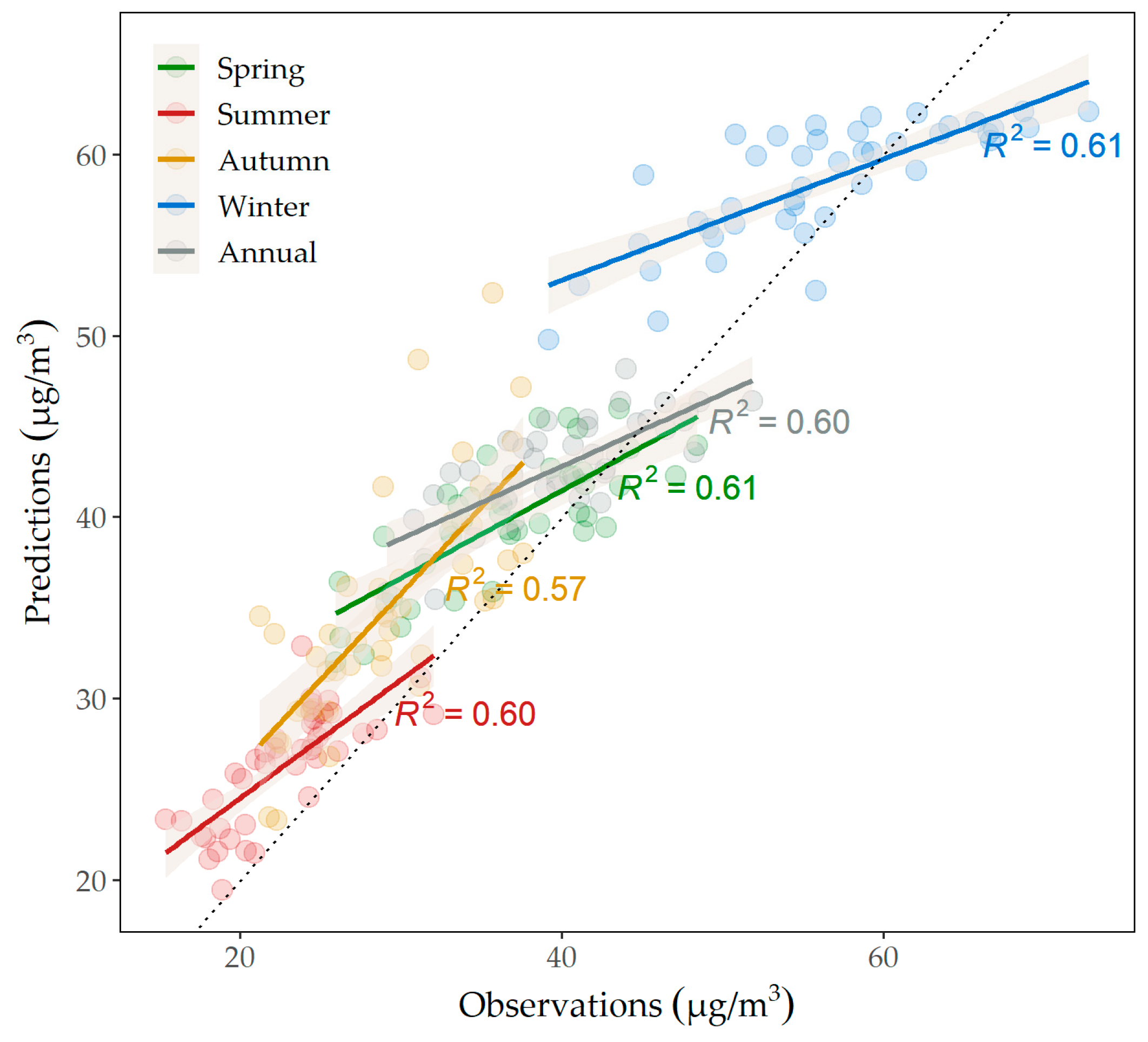

| Category & Variables | Description | Units | |
|---|---|---|---|
| Geographic location | |||
| 1 | X | Longitude | °E |
| 2 | Y | Latitude | °N |
| 3 | DEM | Elevation | m |
| Population count | |||
| 4 | pop_count | Population count | |
| Road information | |||
| 5 | road_n a | The cumulative road length within a radius of n a m | m |
| 6 | dist_road | Distance to the nearest road | m |
| 7 | dist_intersection | Distance to the nearest road intersection | m |
| Land use | |||
| 8 | Tree cover_n a | Proportion of tree cover within radius of n a m | % |
| 9 | Shrubland_n a | Proportion of shrubland within radius of n a m | % |
| 10 | Grassland_n a | Proportion of grassland within radius of n a m | % |
| 11 | Cropland_n a | Proportion of cropland within radius of n a m | % |
| 12 | Built-up_n a | Proportion of built-up area within radius of n a m | % |
| 13 | Bare vegetation_n a | Proportion of bare vegetation within radius of n a m | % |
| 14 | Permanent water bodies_n a | Proportion of permanent water bodies within radius of n a m | % |
| 15 | Herbaceous wetland_n a | Proportion of herbaceous wetland within radius of n a m | % |
| Building height | |||
| 16 | BH_n a | Average building height within radius of n a m | M |
| Meteorological factors | |||
| 17 | WS | Wind speed | m/s |
| 18 | SNSR | Surface net solar radiation | J/m2 |
| 19 | TEMP | Temperature of air at 2 m | °C |
| 20 | RH | Relative humidity | % |
| 21 | SP | Pressure of the atmosphere on the surface | Pa |
| 22 | LST | Land surface temperature | °C |
| Vegetation index | |||
| 23 | NDVI | Normalized difference vegetation index | |
| Atmospheric composition | |||
| 24 | AOD | Aerosol optical depth | |
| 25 | O3_C | Total atmospheric column of O3 | mol/m2 |
| 26 | HCHO_TC | Tropospheric HCHO column number density | mol/m2 |
| 27 | NO2_TC | Tropospheric vertical column of NO2 | mol/m2 |
| Landscape metrics | |||
| 28 | AI_n a | (Aggregation metric) Aggregation index within radius of n a m | % |
| 29 | SPLIT_n a | (Aggregation metric) Splitting index within radius of n a m | % |
| 30 | IJI_n a | (Aggregation metric) Interspersion and Juxtaposition index within radius of n a m | % |
| 31 | FRAC_MN_n a | (Shape metric) Mean fractal dimension index within radius of n a m | |
| 32 | PAFRAC_n a | (Shape metric) Perimeter-Area fractal dimension within radius of n a m | |
| 33 | SHDI_n a | (Diversity metric) Shannon’s diversity index within radius of n a m | |
| 34 | LPI_n a | (Area and Edge metric) Large patch index within radius of n a m | |
| Model | Predictor Variables with Partial R2 | adj. R2 | LOOCV | |
|---|---|---|---|---|
| Rcv2 | RMSE | |||
| Annual | DEM (0.05), Tree cover_500 (0.11), Bare vegetation_5000 (0.18), Grassland_50 (0.17), SP (0.10), HCHO_TC (0.10) | 0.70 | 0.62 | 3.35 |
| Spring | DEM (0.06), Tree cover_5000 (0.04), Built-up_5000 (0.06), Shrubland_500 (0.08), SP (0.06), AOD (0.01) | 0.69 | 0.65 | 3.47 |
| Summer | Bare vegetation_5000 (0.17), SNSR (0.27), NO2_TC (0.13), AI_2000 (0.10), SPLIT_5000 (0.17) | 0.62 | 0.56 | 2.44 |
| Autumn | pop_count (0.07), Bare vegetation_5000 (0.40), Permanent water bodies_2000 (0.13), SP (0.13), LST (0.13), HCHO_TC (0.08), NO2_TC (0.10) | 0.69 | 0.63 | 3.04 |
| Winter | X (0.04), DEM (0.09), Tree cover_500 (0.29), Grassland_50 (0.15), SP (0.04), NO2_TC (0.01) | 0.68 | 0.61 | 4.99 |
Disclaimer/Publisher’s Note: The statements, opinions and data contained in all publications are solely those of the individual author(s) and contributor(s) and not of MDPI and/or the editor(s). MDPI and/or the editor(s) disclaim responsibility for any injury to people or property resulting from any ideas, methods, instructions or products referred to in the content. |
© 2024 by the authors. Licensee MDPI, Basel, Switzerland. This article is an open access article distributed under the terms and conditions of the Creative Commons Attribution (CC BY) license (https://creativecommons.org/licenses/by/4.0/).
Share and Cite
Shi, T.; Zhang, Y.; Yuan, X.; Li, F.; Yan, S. Spatial Patterns and Determinants of PM2.5 Concentrations: A Land Use Regression Analysis in Shenyang Metropolitan Area, China. Sustainability 2024, 16, 5119. https://doi.org/10.3390/su16125119
Shi T, Zhang Y, Yuan X, Li F, Yan S. Spatial Patterns and Determinants of PM2.5 Concentrations: A Land Use Regression Analysis in Shenyang Metropolitan Area, China. Sustainability. 2024; 16(12):5119. https://doi.org/10.3390/su16125119
Chicago/Turabian StyleShi, Tuo, Yang Zhang, Xuemei Yuan, Fangyuan Li, and Shaofang Yan. 2024. "Spatial Patterns and Determinants of PM2.5 Concentrations: A Land Use Regression Analysis in Shenyang Metropolitan Area, China" Sustainability 16, no. 12: 5119. https://doi.org/10.3390/su16125119
APA StyleShi, T., Zhang, Y., Yuan, X., Li, F., & Yan, S. (2024). Spatial Patterns and Determinants of PM2.5 Concentrations: A Land Use Regression Analysis in Shenyang Metropolitan Area, China. Sustainability, 16(12), 5119. https://doi.org/10.3390/su16125119





